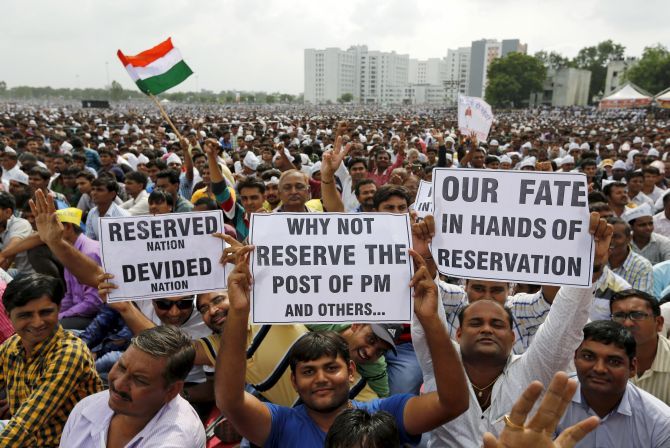With the Patidar protests in Gujarat and the Gujjars in Rajasthan, the demand of traditionally dominant castes demanding quotas in government jobs is on the rise.
While many of these castes are ahead in the social space, ground surveys have found that several members of the dominant castes are in economic conditions quite similar to that of peer communities with the advantage of quotas. Akshat Kaushal & Mayank Mishra report.

Marathas, a prominent caste in Maharashtra, have dominated state politics for about five decades.
While their share in the state’s population has been slightly in excess of 30 per cent, they have consistently captured more than 40 per cent of the seats in the legislative assembly since 1962. Leaving aside seats reserved for scheduled castes and tribes, the community’s share in the assembly has been close to the halfway mark all these years.
Of the state's 18 chief ministers, a majority were Marathas. And, most of the sugar cooperatives, district cooperative banks and educational institutions are reportedly controlled by Marathas.
Yet, the community has for close to a decade been demanding reservation at par with socially and educationally backward classes.
Patidars, a prominent community in Gujarat, much like the Marathas, have enjoyed dominance in various walks of life. About 27 per cent of all industrial units, big and small, are reportedly owned by its members. Roughly 10-15 per cent of the community are settled abroad and considered to own thriving businesses there. Patidars, popularly known as Patels, are reported to have considerable hold over businesses as diverse as diamonds, textiles and construction in the state. The community has enjoyed considerable political power, too.
This community has also been demanding inclusion in the Other Backward Classes category and has launched an agitation in the state.
Jats, another dominant community, spread over Haryana, Punjab, Rajasthan and Uttar Pradesh, are considered another prominent social group in the same category. They constitute nearly two per cent of the country’s population. Haryana was in news recently because a non-Jat leader was made the chief minister after 18 long years.
Members of the community had earlier turned down the offer of being included in the OBC. Now, this group, which already has reservation in Haryana, Rajasthan and Uttar Pradesh, wants inclusion in the Centre’s OBC list. The earlier United Progressive Alliance government had given them this status but the decision was struck down by the Supreme Court earlier this year.
Why are these erstwhile dominant castes demanding inclusion in the category of OBCs? “Reservation has ceased to be a tool for social justice. It is now being increasingly seen as the only tool available for upward social mobility,” says Sudhir Panwar of Lucknow University, who has closely watched the unfolding of the politics of Jats. He says how much premium is attached to government jobs can be understood from the fact that 2.3 million applications came recently for 368 posts of peons with the Uttar Pradesh government.
| THE EQUATIONS |
|
MARATHAS
PATELS
JATS
|
“We will have to seek an answer in the economic development model we have adopted since the 90s. It has led to more inequality and has resulted in marginalisation of a large number of people even in communities otherwise considered dominant,” says Arjun Patel of the Surat-based Centre for Social Studies. He has been an observer of the socio-economic conditions of Patidars in Gujarat.
Are dominant communities really losing their economic dominance, forcing them to seek compensation elsewhere? Two studies by prominent social scientists do indicate rising distress among Jats and Marathas.
A survey among 2,000 rural households in five districts of weestern Uttar Pradesh by Ajit Kumar Singh of the Lucknow-based Giri Institute of Development Studies, some years earlier, show that in socio-economic indices, there is very little to choose between Jats and other castes who are already part of the OBCs.
The average total household income of Jats at Rs 31,202 was found to be lower than that of Yadavs (Rs 37,478) and Gujjars (Rs 32,954). On representation in government jobs, the condition of Yadavs was among the best of the lot, followed by Jats and Gujjars. In private sector jobs, the proportion of Yadavs and Gujjars was higher at 2.3 per cent and 1.7 per cent, respectively, compared to 1.3 per cent for Jats.
So, Ajit Kumar Singh argues, “When a community feels other communities in their region, economically and socially in similar conditions, are getting the benefits of reservation, they also claim for the same status.” (EPW, April 2011)
A recent paper by two prominent political scientists -- Rajeshwari Deshpande and Suhas Palshikar of Savitribai Phule Pune University -- show the condition of large numbers of Marathas is similar. The authors quote from surveys by the Centre for the Study of Developing Societies that around 20 per cent of sampled Maratha respondents were landless labourers and 15 per cent had less than three acres each. The survey found only three per cent of rich Marathas among the sampled families in 2014.
The authors conducted another survey in 2013 among 800 households in two villages, one in Western Maharashtra and the other in Marathwada, and concluded that “land ownership patterns suggest nearly 65 per cent of Marathas are poor, whereas hardly four per cent own more than 20 acres of land and thus may be classified as rich farmers”.
Patidar leaders who have launched an agitation to demand reservation in jobs and education give similar figures to buttress their claims.
They say nearly 60 per cent of Patidars live in villages, and of these, 30 per cent are small and marginal farmers, by the size of land holdings. As reported by this newspaper, Patidar leaders say that as the sons and daughters of these marginal farmers are looking for options other than agriculture, the going has been increasingly getting tougher for them.
Another point they highlight is that when it comes to giving the daughter away in marriage, Patidar parents are increasingly choosing a jobwaale daamaad (employed groom) over a farmer groom, for the income security the former provides.
These studies, though not exhaustive, do indicate the economic condition of Marathas, Jats and Patels have deteriorated over the years.
Since they still enjoy considerable hold over political power in their respective states, members of these communities perhaps feel they can use their bargaining power to extend the benefits of reservation in government jobs and educational institutions to their communities.











